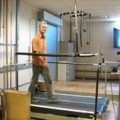Many fitness advocates exercise with the motto, No Pain, No Gain. But the idea that exercise has to be hard in order to do any good makes many people who start to exercise decide it's not worth it. Now, scientists think they're found a fitness routine that can be sustained, even by people who are overweight. That exercise is walking, at a special pace.
World-class triathlete Ray Browning has won many competitions in which he swam four kilometers, biked 200, then topped it off by running 40. He recalls, "I did mostly long races and was certainly good enough at it to make a living for ten years." He still exercises regularly, and as a researcher at the University Health Sciences Center in Denver, studies how to help those who don't like to exercise, especially people who are overweight. Browning notes that the government recommends at least half an hour of moderate exercise a day, and that few Americans do that. " We've been so vigorously advocating that people do lots of exercise, we've sort of forgotten that it's created a barrier," he says. That led him to wonder whether the national guidelines are actually discouraging people from getting fit, and if a less strenuous even casual workout could be as beneficial.
To begin his search for that workout, Browning turned to the most basic kind of exercise: walking. During treadmill studies, he and his colleagues have found that most people enjoy a leisurely pace, around four or five kilometers per hour. But when the pace picks up, Browning says that people who are extremely overweight tend to become extremely uncomfortable, as measured on a scale of one to ten. "An obese woman walking at a brisk walking speed would say it's a 7 or an 8. It's actually quite strenuous," he explains. "Whereas a normal weight male would say it's a 2 or a 3, [easy enough that he might say] "Well, sure, I could do this pretty much for a substantial portion of the day without significant fatigue.'" Browning's colleague, Rodger Kram, is a professor of physiology at the University of Colorado. He says that pushing people to walk fast can be hard on their joints. That's especially true for overweight people, since they tend to toddle when they speed up. "They are exerting very powerful lateral forces, pushing out from side to side with each of their legs. We think it's bad to exert these high lateral forces. If you walk a little bit slower, those lateral forces are less, [especially for] thin people, obese people, very obese people." He notes that for everyone, even walking at a slightly slower pace decreases the load on the joints dramatically.
Kram disagrees with the exercise motto, No Pain, No Gain, suggesting it's actually the other way around. "Our biomechanical data are suggesting that [by] walking faster, particularly in overweight and obese people, the loads being placed on the knee joints are very high. So 'take it easy' actually means less pain, and taking it easy and walking a little slower, but walking a decent distance, is going to burn a fine number of calories." That's good news for people who don't like strenuous exercise. As Ray Browning explains, it means a regular, comfortable daily walk of a few kilometers, at an easy pace, could be just what they need, and all that they need, to get them started on the road to fitness.

